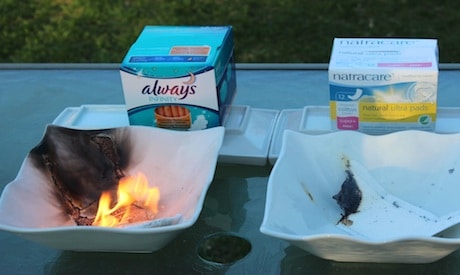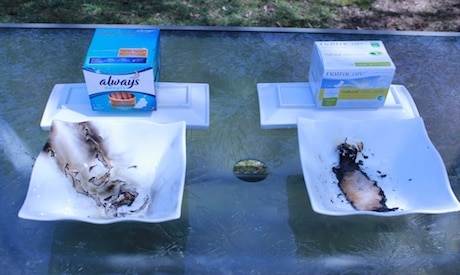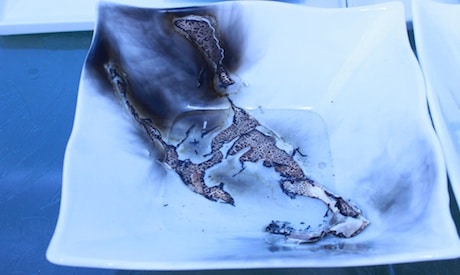
[A MUST SEE! Andrea sets fire to Always Infinity and Natracare pads. The Always Infinity pad burns rapidly potentially indicating petrochemicals, plastics, and other chemicals, while the Natracare pad hardly burns.]
Sign our petition now: http://chn.ge/10hDR2w
I’m a vigilant label reader and have been since I first began to uncover the toxic additives that make seemingly healthy food, junk food. The same is true of the supplements I take and the cosmetic products I put on my body. I’ve learned to look for dangerous chemicals disguised in harmless words like “fragrance” or “made with natural ingredients.” But it wasn’t until researching my book Label Lessons: Your Guide to a Healthy Shopping Cart (with co-author Lisa Tsakos), that I learned firsthand how tampons and sanitary pads, products that alleviate some of the confines of our monthly cycle, might actually be harming our bodies.
Here’s what I found out:
- Conventional tampons and sanitary pad companies don't have to fully disclose their ingredients.
- Conventional tampons are typically manufactured using a blend of synthetic rayon and cotton because it’s cheaper to produce than cotton alone and it has a higher capacity for absorbing liquid. Rayon is a cellulose fiber made from wood pulp. It has been associated with Toxic Shock Syndrome (TSS), a systemic, and potentially deadly, illness caused by bacteria associated with the use of tampons. According to the Mayo Clinic:
“Researchers don't know exactly how tampons may cause toxic shock syndrome. Some believe that when superabsorbent tampons are left in place for a long time, the tampons become a breeding ground for bacteria. Others have suggested that the superabsorbent fibers in the tampons can scratch the surface of the vagina, making it possible for bacteria or their toxins to enter the bloodstream."
Read more about Toxic Shock Syndrome (TSS)
- Conventional tampons and sanitary pads are bleached using chlorine dioxide. Although the process is technically “chlorine-free,” it produces dioxins as a byproduct released into the environment. In 1998, the EPA outlawed a much more potent dioxin-producing bleaching process, and while the newer process significantly reduces dioxins, some experts believe it doesn’t eliminate them entirely from the end products. According to the EPA, dioxin exposure causes cancer in lab animals and poses a high risk to humans as well.
- Conventional tampons contain pesticides. I’ve long been wary of conventional, non-organic, foods for fear of pesticide residue. All the while, conventional cotton, the most heavily sprayed crop in existence, is used in the tampons that women use each and every month. Cotton crops make up just 2.4 percent of the world’s land, but each year a whopping $2 billion is spent on pesticides to spray this one crop. If tampons were a fruit or vegetable, they would most certainly be added to the top of the Dirty Dozen Plus™ list.
- Tampons and pads with odor neutralizers and other artificial fragrances are nothing short of a chemical soup laced with artificial colors, polyester, adhesives, polyethylene (PET), polypropylene, and propylene glycol (PEG), contaminants linked to hormone disruption, cancer, birth defects, dryness, and infertility. We are becoming more aware of the dangers associated with chemicals in everyday products including lotions, shampoos, shower curtains, household cleaners, etc. but we need to stop and think about the tampons and sanitary pads we put into and onto our bodies every single month.
- While doing our research, we found very little information on this topic. We really had to dig deep.
- In 2003, House Representative Carolyn Maloney introduced legislation that would have required research into the health risks posed by additives found in feminine hygiene products. The suspected risks included endometriosis, cervical cancer, breast cancer and ovarian cancer. This legislation didn't pass. We recently called Carolyn Maloney's office to inquire whether any new legislation has been put forth since 2003 and they confirmed nothing has. It's been over 10 years since concern arose that the chemicals in tampons and pads could potentially harm women's reproductive organs. So why wouldn't legislation to research the issue be brought back to the table over and over again until something is done about it?
- Many conventional sanitary pads include latex, a potential allergen. Latex can be used to make the wings on pads more flexible, and it can be used as a binder on the surface of pads and liners, where it comes in close contact with the skin.
- Ninety percent of conventional sanitary pads are made from crude oil plastic. The rest is made from chlorine-bleached wood pulp. By using plastic laden feminine hygiene products, we add the equivalent to 180 billion plastic bags to our waste stream.
- Conventional tampons most probably contain genetically modified organisms (GMOs). According the USDA, 94 percent of all the cotton planted in the U.S. is genetically engineered.[1] GMOs have been linked to a host of health issues[2] including food allergies, leaky gut syndrome, and inflammation, just to name a few. By purchasing conventional tampons you are essentially supporting GMO grown [cotton] crops.
If you haven’t yet seen the GMO documentary film Genetic Roulette, I highly recommend it. I had the chance to hear the film’s director Jeffrey Smith speak in April and he showed that the evidence linking GMOs to health issues is something we can no longer ignore.
This led me to think. Is inserting a GMO tampon into your vagina several times every month any different than ingesting GMO food? According to Dr. Susan Treiser, MD., the skin around the vaginal area is highly vascular and therefore more permeable to a wide range of compounds. I am not a doctor or scientist, but logic suggests that GMOs, pesticides or chemicals in the body—from either end—can’t be good for us.

[Notice how much bigger the flame is on the Always Infinity pad, while the Natracare pad hardly burns].
Tampons and Pads Considered ‘Medical Devices’
Pick up a box of conventional sanitary pads and try to read the ingredients. You can’t because they aren’t listed. Why, you ask? Because sanitary pads are considered to be a “medical device” and because they aren't inserted into our body, the ingredients don’t have to be listed on the label or disclosed by the company. Many brands of tampons do list some of the ingredients on their package, but full disclosure isn't mandatory. According to the FDA, proprietary ingredients and formulas are legally protected and do not have to be disclosed by companies.
Since when is a tampon or pad a “medical device?” I was curious what the definition of a “medical device” was so I looked it up.
According to the FDA[3], a medical device is:
“An instrument, apparatus, implement, machine, contrivance, implant, in vitro reagent, or other similar or related article, including a component part, or accessory which is:
- Recognized in the official National Formulary, or the United States Pharmacopoeia, or any supplement to them,
- Intended for use in the diagnosis of disease or other conditions, or in the cure, mitigation, treatment, or prevention of disease, in man or other animals, or
- Intended to affect the structure or any function of the body of man or other animals, and which does not achieve its primary intended purposes through chemical action within or on the body of man or other animals and which is not dependent upon being metabolized for the achievement of any of its primary intended purposes."
Since when are tampons and pads used to diagnose, prevent, or treat disease? Is a woman’s menstrual cycle considered a disease?
What’s worse—even if ingredients were listed, genetically modified ingredients wouldn’t be, because in the United States and Canada, unlike most industrialized nations, they don’t have to be.

[Notice the residue fused to the bowl of the Always Infinity pad. There was no residue left from the Natracare pad.]
Sign our petition: http://chn.ge/10hDR2w
Safe Alternatives to Conventional Tampons
This toxic mess has flown under the radar for so long because companies like Procter & Gamble are not obligated to label their products.
Luckily, our extensive research also uncovered safe alternatives.
I spoke to Dr. Philip Tierno, a Clinical Professor of Microbiology and Pathology at NYU Medical Centre, who explained, "100 cotton tampons consistently test under detectable levels for TSS toxins."
In Label Lessons, we look at Natracare, a line of feminine hygiene products with all the effectiveness and none of the toxins. Since tampon absorbency is regulated by the FDA, all tampons, organic and conventional, must meet strict absorbency guidelines. Natracare uses 100 percent organic cotton so there are no synthetic ingredients and no GMO cotton. And because the company uses hydrogen peroxide to bleach its products, they are also 100 percent dioxin-free. They’re wrapped in chlorine-free paper, the packaging is recycled, and they’re never tested on animals.
Other great safe feminine hygiene alternatives include the Diva Cup, Lunapads, and Maxim Organic Cotton tampons and pads.
The Environmental Perspective
In my lifetime, I’ll use 17,000 sanitary care products, so what I use matters, both for myself and for the planet, especially considering all the pesticides that create dead zones in our soil and water systems. And then there’s the crude oil plastic, which makes up 90 percent of conventional sanitary pads and is used in plastic applicator tampons. One conventional sanitary pad, for example, uses the equivalent of four plastic bags. Organic products like Natracare, on the other hand, are plastic-free.
As women, not knowing what goes into and onto our bodies every single month sets us back decades. But even still, it’s not just a women’s issue. If you have a wife, daughter, mother, or sister, this issue impacts you as well.
Conventional tampon producers need to disclose what’s in their products; they need to be honest so that women can make safe, informed decisions about what they put in their bodies.
Read more about the fibers in tampons
Personally, I use Natracare tampons and pads and have been for more than ten years. I have met Susie Hewson, the founder of the company, on several occasions and I am inspired by her passion and dedication to women’s health, and the environment.
We called Procter & Gamble on many different occasions to ask them to disclose what’s in their Always Infinity Pad. All they could tell us was that it contained foam and a proprietary formula called Infinicel™, a super absorbent material with more than 60 patents[4]. This was a very frustrating experience for us, as well as for P&G's customer service representatives, because they are kept in the dark about the ingredients as well.
I can’t decide which is worse, the fact that we still don’t know what’s in a product that so many women use every month or that Procter & Gamble isn’t obligated to tell us what their pads are made of, even when we go out of our way to call them.
Disclosing what’s in the products they make that go in and on women’s bodies should not be optional, it should be mandatory!
We need companies to be accountable for the products they manufacture. We need to know ahead of time how to avoid the rayon, pesticide residue, GMO cotton, dioxins, chemical toxins, petrochemicals, and plastic often found in conventional feminine hygiene products.
We need to have full disclosure labeling on tampons and pads so, as women, we can make informed decisions when it comes to the products we buy.

[A close up of the Always Infinity pad after the fire was extinguished. Notice the residue fused to the plate.]
Join me, and the Naturally Savvy team, in putting an end to this breach of public trust by signing our petition to force Procter & Gamble to tell us what’s in their products.
Please leave a comment below letting me know if you are planning on changing to an organic brand, or if you are already using one. I'd love to hear from you.
Sign our petition by clicking on the image below:
To learn more about what’s in tampons and pads and how to eliminate other products that contain harmful ingredients from your shopping cart, download our e-book Label Lessons: Your Guide to a Healthy Shopping Cart.
To read a full report on the dangers of chemicals in feminine care products from Women's Voices For The Earth, please click here.
Do you follow us on Twitter and 'like' us on Facebook? If not, please do! We update it regularly with breaking news stories, special giveaways, and content on how to live a healthier lifestyle.
DISCLAIMER: This article contains affiliate links, which means that if you click on one of the product links, Naturally Savvy will receive a small commission so we can keep pumping out amazing articles like this one. Thank you so much for your support!
References:
[1] http://www.ers.usda.gov/data-products/adoption-of-genetically-engineered-crops-in-the-us/recent-trends-in-ge-adoption.aspx#.UYcVJYKSN0o
[2] http://articles.mercola.com/sites/articles/archive/2012/09/15/genetic-roulette-gmo-documentary.aspx
[3] Is The Product A Medical Device?
[4] Conventional Feminine Care Products: A Women’s Issue With Toxic Implications
[5] For a full ist of references, click here and refer to pages 23, 23, 24 & 25 in our e-book, Label Lessons: Your Guide to a Healthy Shopping Cart











